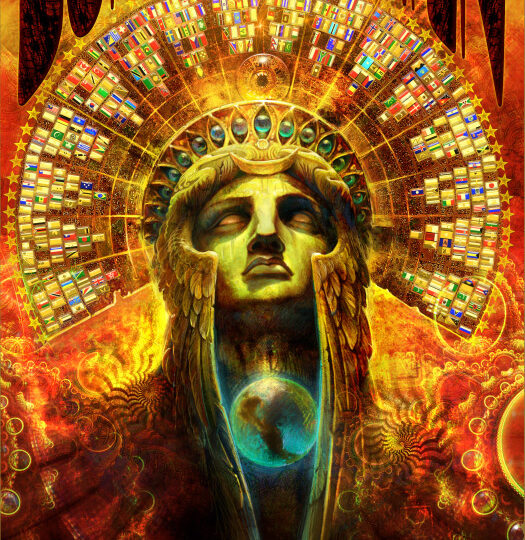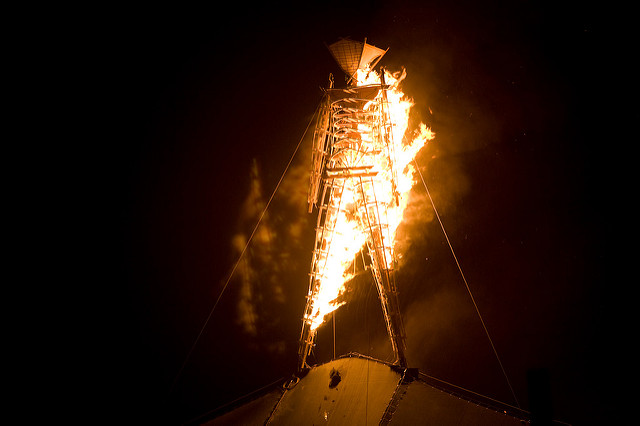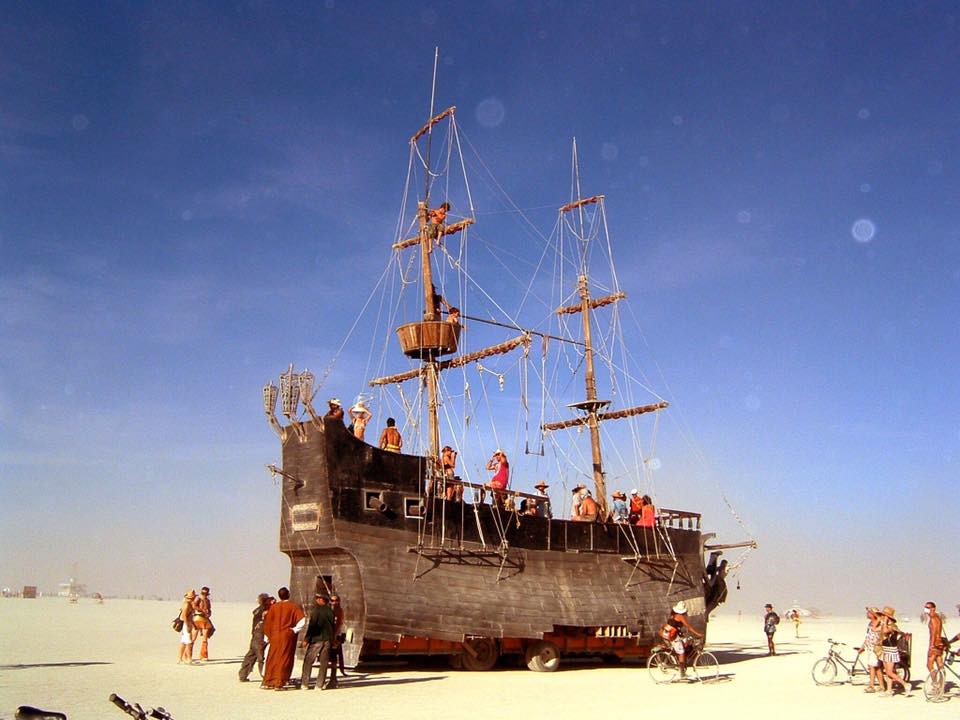
Burning Man’s Spanish Galleon on a Bus
On a recent Friday night, with a full moon glowering waxy from above, a feline and freaky crowd gathered on a toxic finger of San Francisco’s bayside no-man’s-land to bid symbolic adieu to one of the most powerful works of art that the Burning Man arts festival has ever seen: the great dame La Contessa. A massive Spanish galleon encased around a bus, with crow’s nests and rigging and a scuttlebutt for all I know, La Contessa was, on the playa anyway, a manifest dream, a fully realized mobile archetype that featured such fetishistic and finely-grained detail that it became a vessel in more than a literal sense. Standing on the bow at night, the Dutchman sails flying above, a bardo-shaking brass band drowning out sense, and some unseen meth-head driving too fast or erratically for your own cowardly comfort, one did not need drugs to achieve the escape velocity of full imaginative transport. And on Dec 6 of last year, this great vessel of the wayward spirit, its forty feet parked on a ranch in Washoe County, Nevada, was torched to ruin by a local landowner who never hid his hatred of Burning Man, and whose legally dubious and almost certainly vengeful act is parsed, along with much else, in Steven T. Jones’ solid SF Guardian cover story.
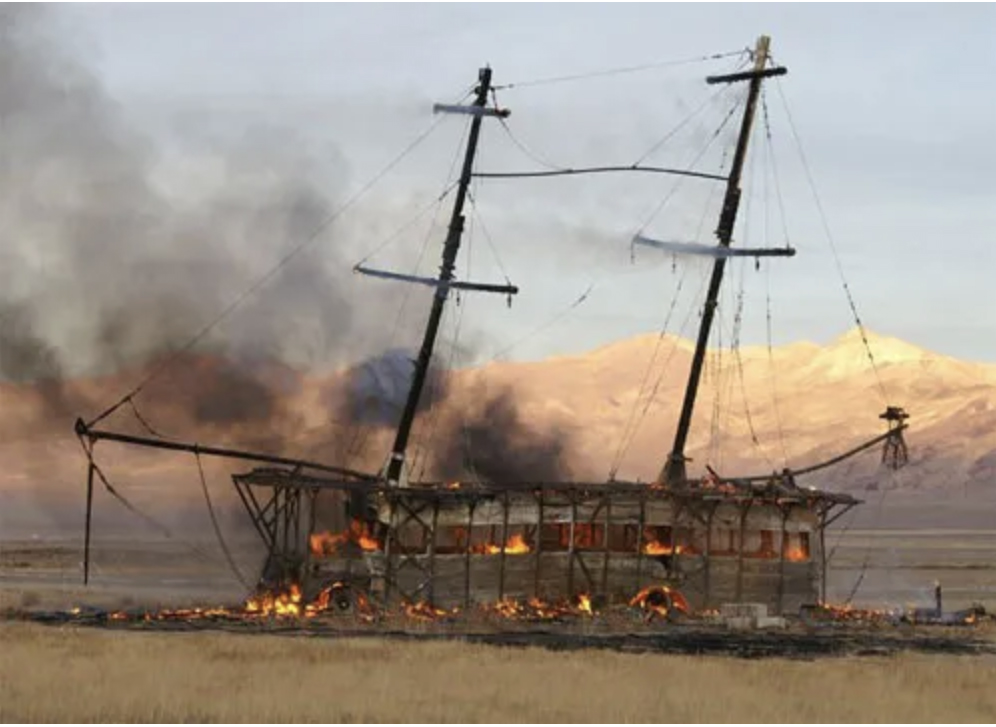 The creation of Simon Cheffins, Greg Jones, and the bulk of the Extra Action Marching Band, La Contessa made her first appearance at the festival in 2002. It was the year of the “Floating World,” which is hands down my favorite Burning Man theme. Unlike so many themes, which are frustratingly abstract, and almost preachy, the obvious nautical reading of the “Floating World” transformed the playa itself into an easy-access creative space, where some bonehead’s blow-up octopus toy helped contribute to the collective hallucination as much as a marvel like La Contessa or those striking jellyfish. Moreover, the playa at night already is a sort of sea: the ocean of the unconscious, of drifting, fragmentary dreams within which one alternately sinks or swims. Or sails, in the case of this gorgeous, slutty galleon, which cut across the open lakebed like the Pequod in pursuit of a white leviathan, a scenario that, blessed be, actually manifested itself that ageless weekend in 2002, when La Contessa played nautical chicken with a monstrous glowing whale whose innards — another bus — were driven by the notorious Flash. The insane and patently unsafe jousting of these two behemoths, glimpsed by me and my pals from a few hundred yards away, was a vision of such fantastic hilarity that it seems incredible to report that the scenario was raised to an even higher pitch of glorious absurdity by the spectacle, an hour or so later, of the white whale being ticketed by distinctly unamused BLM rangers.
The creation of Simon Cheffins, Greg Jones, and the bulk of the Extra Action Marching Band, La Contessa made her first appearance at the festival in 2002. It was the year of the “Floating World,” which is hands down my favorite Burning Man theme. Unlike so many themes, which are frustratingly abstract, and almost preachy, the obvious nautical reading of the “Floating World” transformed the playa itself into an easy-access creative space, where some bonehead’s blow-up octopus toy helped contribute to the collective hallucination as much as a marvel like La Contessa or those striking jellyfish. Moreover, the playa at night already is a sort of sea: the ocean of the unconscious, of drifting, fragmentary dreams within which one alternately sinks or swims. Or sails, in the case of this gorgeous, slutty galleon, which cut across the open lakebed like the Pequod in pursuit of a white leviathan, a scenario that, blessed be, actually manifested itself that ageless weekend in 2002, when La Contessa played nautical chicken with a monstrous glowing whale whose innards — another bus — were driven by the notorious Flash. The insane and patently unsafe jousting of these two behemoths, glimpsed by me and my pals from a few hundred yards away, was a vision of such fantastic hilarity that it seems incredible to report that the scenario was raised to an even higher pitch of glorious absurdity by the spectacle, an hour or so later, of the white whale being ticketed by distinctly unamused BLM rangers.
All gratuitous acts of strong art are magickal invocations, but there is something particularly spellbinding about truly obsessive and basically useless degrees of detail. This is one of the strengths of Peter Jackson’s Lord of the Rings films: the visionary reality of his Middle-Earth was partly a creation of the artisans who designed the props and costumes, and more often than not, added far more detail than the camera would ever pick up. Such excess marked La Contessa’s making as well, a work of manic devotion. Discussing the immense logistical challenges and passionate volunteer work that created the ship, Cheffins told the Guardian that “The idea of the ship is it was a lady that you end up serving, and she took on a life of her own. We all came to feel like servants at some point.” Appropriately, the lady’s most gorgeous feature was her female figurehead (which had already been stolen from the galleon before the ship burned and is presumably still at large). This gorgeous corseted wench, the work of the sculptor Monica Maduro, hung from the prow clutching a lamp, both eyes shut, as if she was leading the ship by feel, or into some nameless alien landscape that unrolled across the screens of her inner eyelids.
Many theme camps and art cars at Burning Man are all façade, like store fronts on a Western set, concealing the usual mess of rebar and wires. And many more are themed in only the loosest sense, settling instead for the goofy juxtapositions and slapdash irony that form the basic — and often lazy and incoherent — foundation of playa art. But once you boarded La Contessa, after suffering the glowering gaze of some haughty Barbary bouncer, you passed through an appealingly soiled interior bordello before reaching the deck, all without glimpsing anything that resembled a modern vehicle. On deck you marveled at the rigging and sails and the weathered balustrade. Then some grizzled and likely sodomite demanded that you please turn off your fucking blinky lights, a demand considered fussy and elitist by some but that merely affirmed the crew’s commitment to the visionary craft.
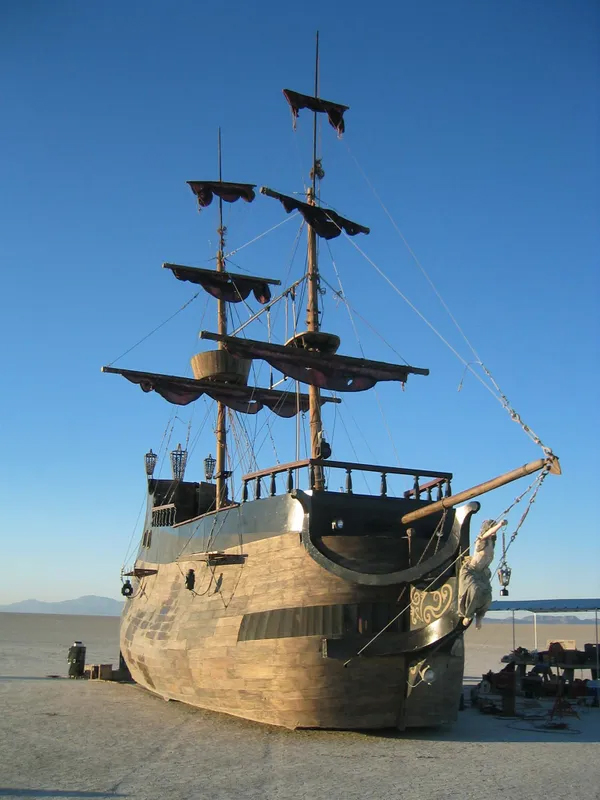 Indeed, by hewing so closely to historical detail, La Contessa was much more straight than your average playa work. I was surely not the only passenger for whom La Contessa instantly resurrected a childhood love of Disneyland’s Pirates of the Caribbean, a ride, by the way, that only fools mock. Like Burning Man, Pirates is a bardo run-through, a sometimes cavernous and claustrophobic cruise through the spectral realms of desire and anarchy and destructive imaginal machines. Think about it, Burners: in its original form, the ride ends with a burning city overrun with madmen high on intoxicants, explosives, and lust. Even more inspiring is the character known in fan lore as the “red-headed woman.” We see her first as a portrait in the drunken skeleton’s lair, a spicy pirate queen equipped with a cutlass, and then later as a woman abducted from the burning town, at which point we realize that the whole ride is a tale told in reverse, like a black mass, and that, once captured, the crimson-topped lass exuberantly embraced her sordid new life of high-seas crime, all before winding up as an image to delight the drunken dead. All very La Contessa, would not you say?
Indeed, by hewing so closely to historical detail, La Contessa was much more straight than your average playa work. I was surely not the only passenger for whom La Contessa instantly resurrected a childhood love of Disneyland’s Pirates of the Caribbean, a ride, by the way, that only fools mock. Like Burning Man, Pirates is a bardo run-through, a sometimes cavernous and claustrophobic cruise through the spectral realms of desire and anarchy and destructive imaginal machines. Think about it, Burners: in its original form, the ride ends with a burning city overrun with madmen high on intoxicants, explosives, and lust. Even more inspiring is the character known in fan lore as the “red-headed woman.” We see her first as a portrait in the drunken skeleton’s lair, a spicy pirate queen equipped with a cutlass, and then later as a woman abducted from the burning town, at which point we realize that the whole ride is a tale told in reverse, like a black mass, and that, once captured, the crimson-topped lass exuberantly embraced her sordid new life of high-seas crime, all before winding up as an image to delight the drunken dead. All very La Contessa, would not you say?
For Friday’s wake, a crew of countess lovers built a small-scale replica of the galleon, a simulacrum of a simulacrum, and all the better for it. The crowd warmed itself with a few hours of whisky and reminiscences and banjo renditions of sea shanties and La Contessa’s two theme songs. A few speeches were made, Moms were thanked, Rimbaud’s “Drunken Boat” was read, and then the Extra Action Marching Band, led by flag girls bearing silvery standards, struck up a dirge punctuated by bullhorn lamentations en francais, and led the crowd and the drunken boat to the damp sands by waterline. Dr. Hal Robbins intoned Tennyson’s “Crossing the Bar,” and the boat was committed to the sea, where it soon ballooned into flame like the Viking burials of yore. The ladies took up another round of “The Countess,” which bounced and echoed off the metal walls of distant industrial buildings like a spectral dub track:
They toiled for a thousand white nights to build the ship that they sail’d,
Bound together with salt & spunk, buckets of bloody nails.
They thought that their task would be easy; they learned their lesson well.
So No! Let it never be foolishly be said
That the countess is easily wooed into bed.

